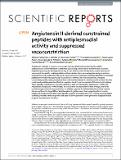| dc.contributor.author | Silva, Adriana Farias | |
| dc.contributor.author | Silva, Leandro Souza | |
| dc.contributor.author | Alves, Flavio Lopes | |
| dc.contributor.author | de Sá Pinheiro, Ana Acácia | |
| dc.contributor.author | Miranda, Antonio | |
| dc.contributor.author | Capurro, Margareth Lara | |
| dc.contributor.author | Oliveira, Vani Xavier | |
| dc.contributor.author | Der Torossian Torres, Marcelo | |
| dc.contributor.author | de la Fuente Nunez, Cesar | |
| dc.date.accessioned | 2017-12-11T19:18:32Z | |
| dc.date.available | 2017-12-11T19:18:32Z | |
| dc.date.issued | 2017-10 | |
| dc.date.submitted | 2017-07 | |
| dc.identifier.issn | 2045-2322 | |
| dc.identifier.uri | http://hdl.handle.net/1721.1/112690 | |
| dc.description.abstract | Angiotensin II (Ang II) is a natural mammalian hormone that has been described to exhibit antiplasmodial activity therefore constituting a promising alternative for the treatment of malaria. Despite its promise, the development of Ang II as an antimalarial is limited by its potent induction of vasoconstriction and its rapid degradation within minutes. Here, we used peptide design to perform targeted chemical modifications to Ang II to generate conformationally restricted (disulfide-crosslinked) peptide derivatives with suppressed vasoconstrictor activity and increased stability. Designed constrained peptides were synthesized chemically and then tested for antiplasmodial activity. Two lead constrained peptides were identified (i.e., peptides 1 and 2), each composed of 10 amino acid residues. These peptides exhibited very promising activity in both our Plasmodium gallinaceum ( > 80%) and Plasmodium falciparum ( > 40%) models, an activity that was equivalent to that of Ang II, and led to complete suppression of vasoconstriction. In addition, peptide 5 exhibited selective activity towards the pre-erythrocytic stage (98% of activity against P. gallinaceum), thus suggesting that it may be possible to design peptides that target specific stages of the malaria life cycle. The Ang II derived stable scaffolds presented here may provide the basis for development of a new generation of peptide-based drugs for the treatment of malaria. | en_US |
| dc.publisher | Nature Publishing Group | en_US |
| dc.relation.isversionof | http://dx.doi.org/10.1038/s41598-017-14642-z | en_US |
| dc.rights | Creative Commons Attribution 4.0 International | en_US |
| dc.rights.uri | https://creativecommons.org/licenses/by/4.0/ | en_US |
| dc.source | Nature | en_US |
| dc.title | Angiotensin II-derived constrained peptides with antiplasmodial activity and suppressed vasoconstriction | en_US |
| dc.type | Article | en_US |
| dc.identifier.citation | Silva, Adriana Farias et al. “Angiotensin II-Derived Constrained Peptides with Antiplasmodial Activity and Suppressed Vasoconstriction.” Scientific Reports 7, 1 (October 2017): 14326 © 2017 The Author(s) | en_US |
| dc.contributor.department | MIT Synthetic Biology Center | en_US |
| dc.contributor.department | Massachusetts Institute of Technology. Department of Biological Engineering | en_US |
| dc.contributor.department | Massachusetts Institute of Technology. Department of Biology | en_US |
| dc.contributor.department | Massachusetts Institute of Technology. Department of Electrical Engineering and Computer Science | en_US |
| dc.contributor.department | Massachusetts Institute of Technology. Research Laboratory of Electronics | en_US |
| dc.contributor.mitauthor | Der Torossian Torres, Marcelo | |
| dc.contributor.mitauthor | de la Fuente Nunez, Cesar | |
| dc.relation.journal | Scientific Reports | en_US |
| dc.eprint.version | Final published version | en_US |
| dc.type.uri | http://purl.org/eprint/type/JournalArticle | en_US |
| eprint.status | http://purl.org/eprint/status/PeerReviewed | en_US |
| dc.date.updated | 2017-12-11T16:57:30Z | |
| dspace.orderedauthors | Silva, Adriana Farias; Torres, Marcelo Der Torossian; Silva, Leandro Souza; Alves, Flavio Lopes; de Sá Pinheiro, Ana Acácia; Miranda, Antonio; Capurro, Margareth Lara; de la Fuente-Nunez, Cesar; Oliveira, Vani Xavier | en_US |
| dspace.embargo.terms | N | en_US |
| mit.license | PUBLISHER_CC | en_US |
